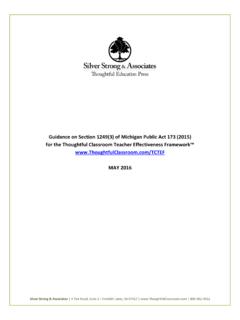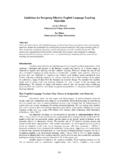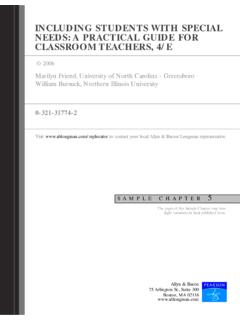Transcription of CHAPTER 7 Key Factors in Developing Effective Learning ...
1 Creating Effective Teaching and Learning Environments: First Results from TALIS ISBN 978-92-64-05605-3219 OECD 2009 CHAPTER 7 Key Factors in Developing Effective Learning Environments: Classroom Disciplinary Climate and Teachers Self-Efficacy220 Highlights221 Introduction and conceptual framework225 Descriptive statistics for teachers reported self-efficacy226 Descriptive statistics for classroom environment227 Teachers characteristics and classroom disciplinary climate and teachers self-efficacy229 Teachers professional development and classroom disciplinary climate and teachers self-efficacy231 Teaching practices, beliefs and attitudes and classroom disciplinary climate and teachers self-efficacy234 Teacher appraisal and feedback and classroom disciplinary climate and teachers self-efficacy238 School leadership and classroom disciplinary climate and teachers self-efficacy239 School autonomy and school climate and classroom disciplinary climate and teachers self-efficacy241 Conclusions and implications for policy and practiceCHAPTER 7 KEY Factors IN DEVELOPINGEFFECTIVELEARNINGENVIRONMENTS: Creating Effective Teaching and Learning Environments: First Results from TALIS ISBN 978-92-64-05605-3220 OECD 2009 Highlights Research has shown that classroom disciplinary climate is associated with student performance and that self-efficacy is an important measure of productivity and effectiveness.
2 Teachers with constructivist beliefs about teaching are more likely to report good classroom disciplinary climate in many countries, but those who emphasise the direct transmission of knowledge in instruction are more likely to teach classes with poorer disciplinary climate. Teachers who hold either of these types of beliefs strongly are more likely to report high self-efficacy. Structured teaching practices and student-oriented teaching practices are both associated with good classroom climate and teachers self-efficacy in many countries. This is less true of other practices identified in the survey. Teacher appraisal is linked in some cases with self-efficacy, particularly when it involves public recognition of teachers progress and is linked to innovative practices. More professional development is often associated with greater teacher self-efficacy, but not generally with more orderly classrooms.
3 Teachers with relatively less experience and stability in their contractual status are significantly less likely to be teaching classes with a positive classroom disciplinary climate or to report high levels of self-efficacy. Teachers who are significantly more likely to report higher levels of self-efficacy are employed on permanent contracts (significant in 7 TALIS countries in the final net models estimated for each country), employed on a full-time basis (6 TALIS countries), and have more experience as a teacher (5 TALIS countries).221 CLASSROOM DISCIPLINARYCLIMATE ANDTEACHERS SELF-EFFICACYCHAPTER 7 Creating Effective Teaching and Learning Environments: First Results from TALIS ISBN 978-92-64-05605-3 OECD 2009 INTRODUCTION AND CONCEPTUAL FRAMEWORKA number of important issues discussed in this report play an important role in school education. CHAPTER 3 discusses the professional development of teachers and issues such as its impact and teachers professional development needs.
4 CHAPTER 4 identifies a number of teaching practices, beliefs and attitudes across TALIS countries and analysed, among other issues, their interaction and the Factors associated with them. Teachers appraisal and feedback is the subject of CHAPTER 5 along with an analysis of school evaluation. CHAPTER 6examines school leadership styles across and within TALIS countries as well as associations between such styles and various aspects of schools operations and the working lives of teachers. All analyses are supplemented by CHAPTER 2 s description of the characteristics of teachers and the schools in which they work. This CHAPTER focuses on two variables which are considered important pre-conditions for teachers professional success: classroom disciplinary climate and teachers self-efficacy (seeTALIS Technical Report [forthcoming] for discussion of the reliability of these indices).
5 It presents an analysis of extensive modelling (described in Annex ) which incorporates variables from the previous chapters and examines their association with classroom disciplinary climate and teachers reported self-efficacy (which are modelled separately). It builds on the analysis in other chapters, which concentrate on the specific issues that are their analytical focus. Separate modelling was conducted for each bloc of independent variables drawn from the earlier chapters estimating classroom disciplinary climate and self-efficacy. Results are contrasted with the effect of including a broad set of teacher background and various socio-economic background characteristics of classrooms and schools which better control for external Factors . The final models are then presented, which include not only these background characteristics but also the significant variables from the estimations for each analytical bloc.
6 This makes it possible to better isolate the variables that affect classroom disciplinary climate and self-efficacy and allows for a better understanding of the interaction of key variables identified in previous analytical model and the choice of dependent and independent variables are discussed to illustrate the development of the modelling presented here. This is complemented by a discussion of the descriptive statistics of teachers reports of self-efficacy and of classroom disciplinary climate. The following section introduces the first results of the modelling and estimates classroom disciplinary climate and teachers self-efficacy against various teacher background characteristics and measures of the socio-economic status of teachers classes and the schools in which they work. Discussion is then presented of estimates of the association of classroom disciplinary climate and self-efficacy with measures of teachers professional development from CHAPTER this is discussion of the next bloc of variables included in the modelling, which encompasses measures of teachers practices and beliefs (discussed in CHAPTER 4) and their association with classroom disciplinary climate and self-efficacy.
7 Estimates of the association between measures of school evaluation and teacher appraisal and feedback (discussed in CHAPTER 5) and classroom disciplinary climate and self-efficacy are then discussed followed by the associations with school leadership styles from CHAPTER 6. Indicators of school climate and school autonomy and their relationship to the dependent variables are then discussed and finally concluding comments are presented. Analytical modelThe analytical model presented in this CHAPTER builds upon the previous chapters of this report. CHAPTER 4presents an analytical framework for the modelling presented in that CHAPTER (see Figure ). It illustrates how the various aspects of schooling that are the focus of TALIS are expected to be associated with Effective schooling, with a particular emphasis on teaching practices and beliefs (the focus of that CHAPTER ).
8 Modelling presented in CHAPTER 6 illustrates the associations between particular school characteristics and those of school principals and the leadership styles they adopt. CHAPTER 7 KEY Factors IN DEVELOPINGEFFECTIVELEARNINGENVIRONMENTS: Creating Effective Teaching and Learning Environments: First Results from TALIS ISBN 978-92-64-05605-3222 OECD 2009 The modelling presented here is based on an analytical framework which extends that of previous chapters by including more background and socio-economic characteristics and by drawing on important elements of the analyses presented in all of the earlier chapters. The variables in the modelling include: teacher characteristics which describe their demographic profile and aspects of their employment and careers as teachers; socio-economic background characteristics measured at both the classroom and the school level; professional development characteristics which measure the extent and type of professional development undertaken, drawing on the analysis in CHAPTER 3; teaching practices and beliefs found across TALIS countries, drawing on the analysis in CHAPTER 4; school evaluation characteristics, with a focus upon specific aspects of the frequency and impact of school evaluation, discussed in CHAPTER 5; teacher appraisal and feedback characteristics that detail the frequency, criteria and impact of the appraisal and feedback provided to teachers, as discussed in CHAPTER 5.
9 And school leadership styles that are prevalent across TALIS countries, as discussed in CHAPTER 6. These variables are included in the modelling presented in this CHAPTER , which estimate their association with teachers reports of their self-efficacy and with classroom disciplinary climate. Both classroom disciplinary climate and teachers self-efficacy are included in the analytical framework of CHAPTER 4, and it is important to note the differences with the considerably broader analytical framework for the modelling in this CHAPTER . For example, a greater number of teachers job characteristics and aspects of teachers career structures are included in the modelling presented in this CHAPTER which can be affected by policy. In addition, this CHAPTER includes an analysis of school evaluation processes, of important aspects of teachers appraisal and feedback, and of specific school leadership styles.
10 This enables a broader analysis of the key features of the earlier chapters of the report. This broader approach requires slight changes to the modelling which are discussed focus on self-efficacy and classroom disciplinary climateClassroom disciplinary climate and teachers reports of their self-efficacy are the dependent variables in the modelling presented in this CHAPTER . These variables could also be used as independent variables in other models with a different focus yet, both are considered important in school education and, as discussed below, have been shown to be important in numerous contexts. Classroom disciplinary climate not only affects student outcomes and attainment but is a prominent policy issue in a number of countries and regions (OECD, 2007). Students actions in classrooms and a safe and productive Learning environment are important for many schools and can be a challenging dimension of teachers work.

















